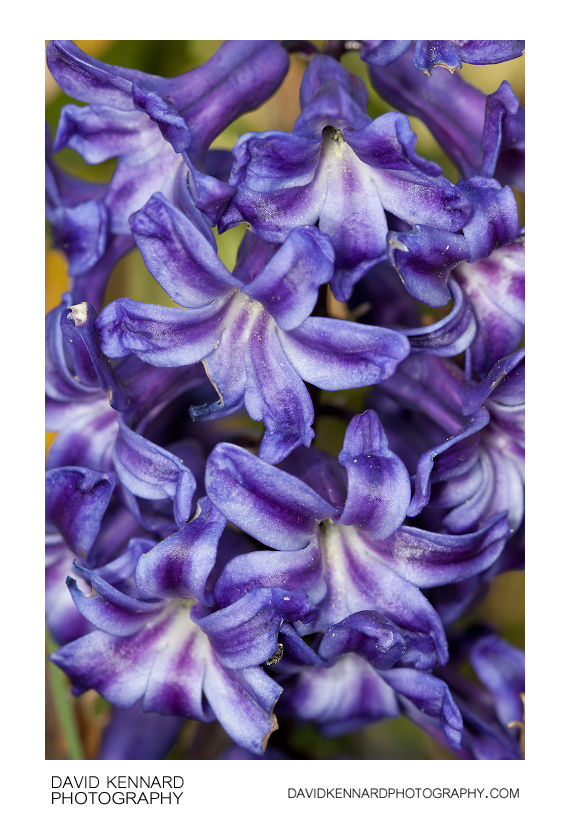Hyacinthus orientalis (Common Hyacinth) purple flowers

Description
- Title:
- Hyacinthus orientalis (Common Hyacinth) purple flowers
- Caption / Description:
-
Hyacinthus orientalis (Common Hyacinth, Garden Hyacinth or Dutch Hyacinth), is a perennial flowering plant of the genus Hyacinthus, native to southwestern Asia, in southern and central Turkey, northwestern Syria, Lebanon and northern Israel. It was introduced to Europe in the 16th century.
It is a bulb plant, with a 3–7cm diameter bulb. The leaves are strap-shaped, 15–35cm long and 1–3cm broad, with a soft, succulent texture, and produced in a basal whorl. The flowering stem grows to 20–35cm (rarely to 45cm) tall, bearing a spike of 2-50 fragrant purple flowers 2-3.5cm long with a tubular, six-lobed perianth.
In Greek mythology, Hyakinthos was a young man admired by Apollo and Zephyr, but killed by a discus in a jealous fight between the two gods. The flower was allegedly named after him when it sprang from his blood.
The reproduction of the plant in cultivation can be done easily by dividing the newly appeared bulbs from the main plant. In the nature, this method is also used by the Hyacinth but the plant has also specific kind of reproduction by seeds.
The plant is pollinated by different insects such as honey bees. The flowers are very fragrant and attract the insects as rewarding them with nectar.
After flowering the ripening of the seed capsules begins. They are fleshy and spherical structures. When the capsules reach maturity, they get dried and split apart on three parts. Every part has two subdivisions and contains different quantity of seeds. The seeds are black grains with one white elaiosome which size can vary. As it looks since the seeds have such structure, they are dispersed through myrmecochory. Ants find the seeds and take them into their burrows where they use the elaiosome for food. There the seeds can germinate.
It has a long history of cultivation as an ornamental plant, grown across the Mediterranean region, and later France (where it is used in perfumery), the Netherlands (a major centre of cultivation) and elsewhere.
The Garden Hyacinth flowers in the early spring. They grow best in full sun to part shade in well-drained, but not dry, soil. It requires a winter dormancy period, and will only persist in cold-weather regions. It is grown for the clusters of fragrant, brightly-coloured flowers. Over 2,000 cultivars have been selected and named, with flower colour varying from blue, white, pale yellow, pink, red or purple; most cultivars have also been selected for denser flower spikes than the wild type, bearing 40-100 or more flowers on each spike.
H. orientalis contains alkaloids and is toxic if eaten in large quantities. The bulb, however, is the most poisonous part and should not be ingested under any circumstances.
Description from Wikipedia: http://en.wikipedia.org/wiki/Hyacinthus_orientalis
- Tags / Keywords:
-
- Biota
- Life
- Vitae
- Eukaryota
- Purple
- Plantae
- Plants
- Magnoliophyta
- Flowering Plants
- Angiosperms
- Liliopsida
- Monocotyledons
- Asparagales
- Hyacinthaceae
- Hyacinthus
- Hyacinthus orientalis
- Common Hyacinth
- Garden Hyacinth
- Dutch Hyacinth
- Cultivar
Admin
- Date Original Photo Taken:
- Original File Name:
- _MG_2518.CR2
- Event:
- Rating:
- ☆
- Date this image added/last updated on website:
- Original File Dimensions:
- 2848px x 4272px
- File Type:
- JPEG
- Color Mode:
- Original Image Color Profile:
- Adobe RGB (1998)
Location
- Location Created:
-
- Sublocation:
- City:
- Market Harborough
- Province/State:
- Leicestershire
- Country:
- United Kingdom
- World Region:
- Europe
- Geo-location:
Rights
- Copyright Status:
- Copyrighted
- Licensing Status:
- Rights Managed
- Available for Editorial Use:
- Yes
- Available for Commercial Use:
- Yes
- Copyright Notice:
- © 2012 Dave Kennard
Camera Data
- Date Digital Resource was created:
- Shutter speed:
- 1⁄160 s
- Aperture:
- f/5.6
- Camera Model:
- Canon EOS 450D
- ISO:
- 200
- Exposure Compensation:
- 0
- Focal Length:
- 100mm
- Focal Length (35mm equiv.):
- Metering Mode:
- Multi-segment
- Flash:
- On, Fired
- Exposure Mode:
- Manual
- White Balance:
- Manual
- Light Source:
- Exposure Program:
- Manual
Additional shooting metadata
- Lens:
- Canon EF 100mm F2.8 Macro USM
- Filters used:
- Additional Optics used:
- Setup:
- Handheld
Canon MT-24EX Macro Twin Flash with home-made 'light tent' diffuser
Post Processing
- Image Modified:
- Software used:
-
- Adobe Camera RAW
- Post Processing:
+0.35 exposure compensation in ACR
